 |
||
|
||
| ||
Not so long ago we tested active wooden stereo J-707 and J-703 sets from Jazz Speakers. They looked quite attractive but at the same time they had some drawbacks, and, first of all, in their amplification part. In 2001 Jazz Speakers released a new model of stereo speakers - J-6508. It has a unique design, an external amplifier and completely different dynamic loudspeakers. Let's see whether the sound is better now. AccessoriesThe J-6508 set ships in a relatively small blue box which contains the following accessories:
AppearanceThe speakers are not big (130 X 237 X 225 mm) and do not take much space on a desk. The cabinets are wooden. The panels are 9 mm wide. The phase inverter which is 80 mm long is output onto the front panel and is placed in the lower part under a wideband loudspeaker. The phase inverter's hole is 33 mm in diameter. 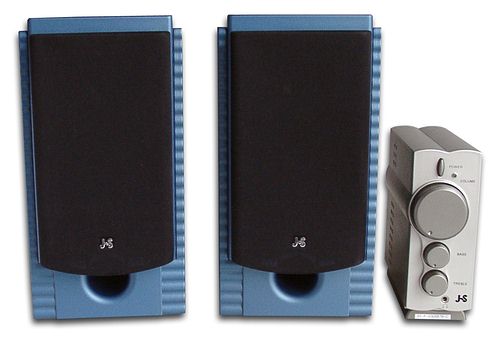 A blue decorative panel which covers a front panel is made of plastic. That is why cone of the loudspeaker are recessed by a couple of centimeters (see the photo with removed grilles). The panel doesn't vibrate when music is played as it is attached with 4 screws 22 mm long. 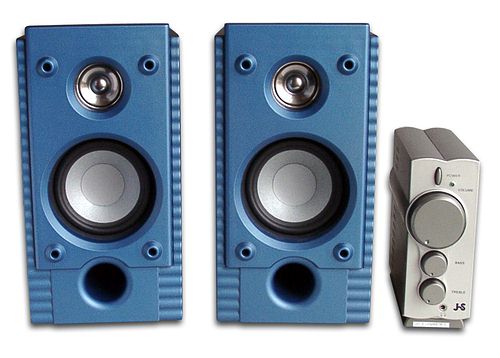 The protective grills are typical of Jazz Speakers. They have a lot of partitions which are rather wide, and therefore, worsen sound conductivity of the protective grills and sound quality. On the other hand, the grills, together with a plastic panel, make the appearance of the speakers original. 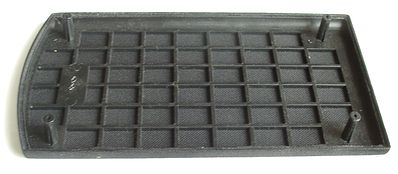 The legs are around 2 cm in diameter. The cables which connect the speakers and an amplifying unit are 3 m long. They are provided thick layer of a wire insulation, and even if you often replace the speakers the cables won't get damaged or break. The connectors are of different colors: the left one is white, the right one is red as always. Amplifying unitThe speakers, as you know, are not active, and the amplifier is put into an external unit.  The unit is to be placed in a vertical position. To make it stable a weighty metallic plate is put into its support. The cabinet is quite small (15 cm high) and you can place it on your desk without any problems (for example, next to a monitor). The front panel contains:
A signal from the headphones jack can be adjusted with tone and volume controls.  The rear panel contains:
The phone-in is used to connect the J-6508 with different stereo devices which have only a headphones output. For example, some CD and MP3 players do not have a line-out. Now let's take a gander at what's inside the amplifying unit. The heatsink of the amplifying chip is really impressive! 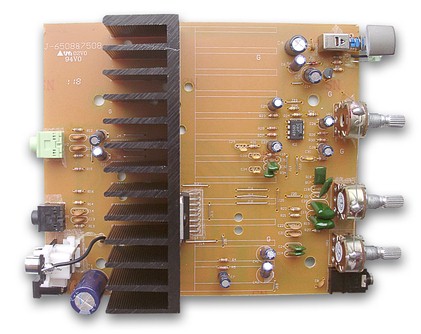 The power amplifier based on a TDA7297 chip. 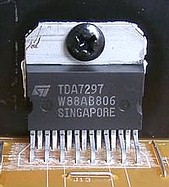 Below is a figure showing how THD depends on power (taken from the specification for the ST TDA7297). 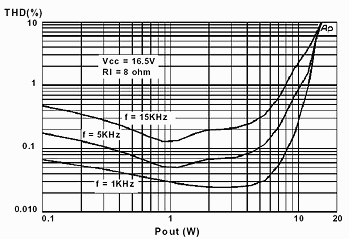 At 1 kHz with an output signal being 10 W at 16.5 V and a load impedance of 8 Ohm the THD is 0.3 %. Taking into account a 12V power supply unit the graphs will shift to the left and instead of 10 W on the power scale we will get 6. So, the power working range for the amplifier is 0.5-6 W. After that distortions grow up rapidly. And for the dynamic loudspeakers with low power value, such characteristics can be considered quite acceptable but not outstanding (because of the distortions) as compared with TDA2030A and LM1875 of the competitors. And I do not understand what the manufacturer means by 28 W RMS and 800 W PMPO on the box. May be it will be with an another amplifier? :) Technical characteristics of the speakersThe power of the high-frequency loudspeaker is 5 W and the impedance is 5 Ohm. The mid-range loudspeaker is of 8 W and 8 Ohm. You should remember that impedance is a full value of resistance to the alternating current measured at 1000 Hz. After that (at the working frequencies of the HF loudspeaker) the resistance usually increases. So there is no any unconventional with 5 Ohm impendance. The tweeter's diffusor is made of silver foil. Its diameter is 3.8 cm. The diffusor of the wideband loudspeaker is 9 cm in diameter. Its flexible corrugation is made of rubber, like in high-quality Hi-Fi speakers, instead of polypropylene like in the J-703/707. The loadspeaker's cone is made of material which looks like kevlar, but just imitating it. Music testsFor these tests we took three compositions of different styles:
Well, to play classical music has been always a problem. The wideband speaker doesn't play lows or they are too quiet. The phase-inverter is set to 100-150 Hz. The mids had a peculiar tint. They are rather flat and too clamorous. The highs seems to be the best in the whole spectrum. But the distortions are still noticeable. We do not try to find fault with the speakers. You may say that you are not gonna listen to a philharmonic orchestra at all, but you should remember that this kind of music is the easiest way to find where speakers are lying. The next two tests show better, more balanced sound. But it is scanty. The lows are lacking most of all. It is very noticeable in a composition with a rich bass part. It is interesting that when we tried to turn up the lows, we got louder low mids instead. The mids are delivered quite good. The highs are too protruding. The volume is enough for an average room. I'd like to add that looking at the diffusors of the wideband speakers you are prepared to hear something more pleasant. Maybe the amplifier doesn't have enough power to shake up those 8-Ohm loadspeakers without distortions. Tests in gamesThe sound in 3d shooter is quite acceptable. High-quality samples in the latest Max Payne game allow us to analyze the sound. The sound in the highs and upper mids is rather good: voices, cries, breaking glass, shooting of guns etc. The lows are worse. It is well noticeable when grenades and gas-cylinders blow up. In quests and strategies the J-6508 plays good as well. But if a soundtrack in the game is performed by a philharmonic orchestra you should turn it down as there are some peculiar tints. AFC measurementLet's take a look at the AFCs of the speakers. The measurements were carried out by the RMAA AE program on a noise signal. 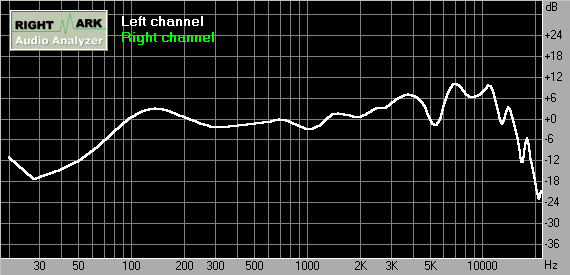 AFC of the J-6508 speaker with a protective grill 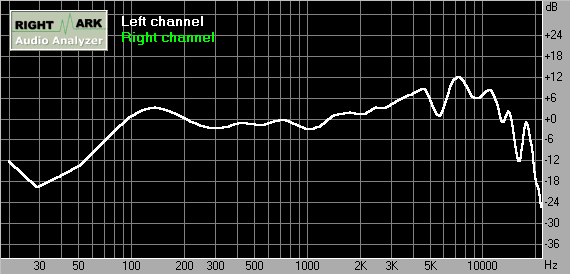 AFC of the J-6508 speaker without a protective grill The measured AFC of the speakers conform with what we heard. The low frequency range is heard only in its upper part even when we add basses. A subwoofer would be very helpful. The mids are more or less even. In the highs you can notice resonances which distort the tembre. But you will hardly hear it. ConclusionWell, the J-6508 is a good choice for games, and for listening to not too loud CD and MP3 music in a background mode. I think the J-6508 plays better than the wooden J-707 or J-703 of the same class. In fact, it is very difficult to compare different speakers, especially of different classes. Each class of acoustic systems is aimed at different applications and excels in certain conditions. It should be noted that Jazz Speakers does its best to improve quality of acoustic systems. Although not everything is shining, Jazz has achieved some improvements in this wooden set of multimedia acoustic system. Highs
Lows
RecommendationsYou can take off the protective grills when listening to music: the sound will be richer in highs.
Write a comment below. No registration needed!
|
Platform · Video · Multimedia · Mobile · Other || About us & Privacy policy · Twitter · Facebook Copyright © Byrds Research & Publishing, Ltd., 1997–2011. All rights reserved. |